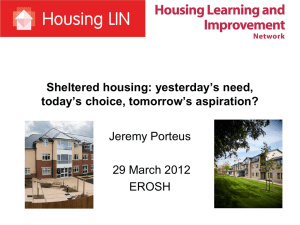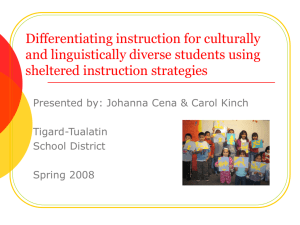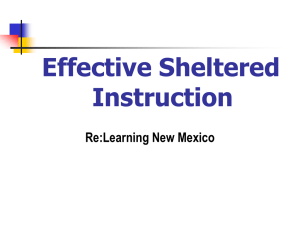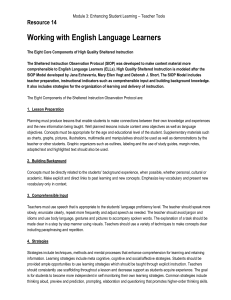her perspective on housing and older people
advertisement
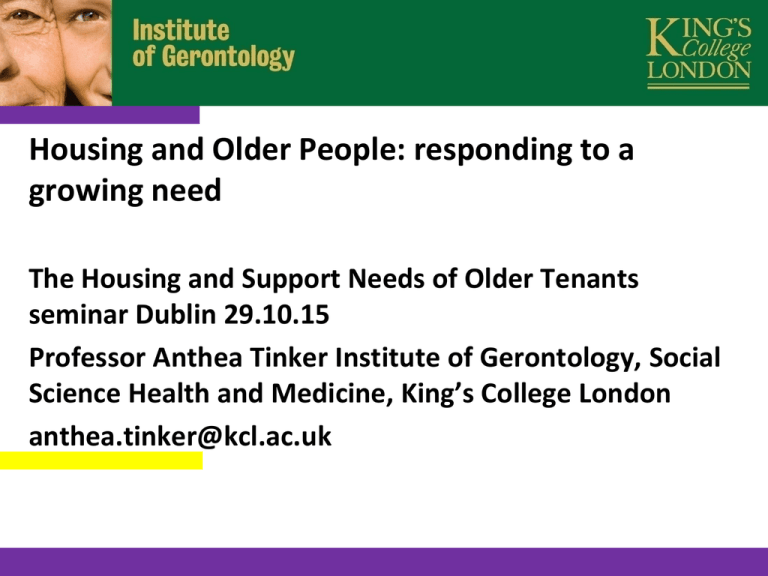
Housing and Older People: responding to a growing need The Housing and Support Needs of Older Tenants seminar Dublin 29.10.15 Professor Anthea Tinker Institute of Gerontology, Social Science Health and Medicine, King’s College London anthea.tinker@kcl.ac.uk Outline of presentation A warm welcome for the report Housing and older people: responding to a growing need A. Specific issues to do with sheltered housing B. Alternatives to sheltered housing C. Some other general issues 1. 2. 3. The importance of outdoor space The importance of housing, universal design and adaptations Investing in assistive technology D. Some conclusions Outline of presentation A warm welcome for the report Especially the mixed methods of quantitative (818 participants) and qualitative (6 focus groups) Good to have sheltered and very sheltered (which is what some of the report is about) as well as mainstream researched Many of the findings echo other research (A minor quibble – I would have preferred the questions about home to refer to this rather than house) Housing and older people: responding to a growing need Including some references to the report A. Specific issues to do with sheltered housing - Lack of knowledge by older people, families and professionals – clear finding in the report which echoes other research - The popularity of sheltered housing (though much seems to be extra care) Points that arise from other research: - Often needs remodelling as not suitable - Sometimes lack of demand when care needs too great A. Specific issues to do with sheltered housing: extra care housing - Generally thought the UK leads the way Early evaluations e.g. Tinker, 1989 showed that it was popular with management, older people and staff but that it was generally more expensive than staying at home with an innovatory service although generally cheaper than hospital or residential care. Extra care housing is especially valuable for frail older people but some schemes are outdated. Specific issues to do with sheltered housing: extra care housing Recent evaluations (e.g. Netten et al, 2012) very positive but important to note that less than 10% of older people live in this form of housing. Key findings were that ‘People had generally made a positive choice to move into extra care housing , with high expectations often focussed on an improved social life. After they had moved in, most people reported a good quality of life, enjoyed a good social life and valued the social activities and events on offer’. Specific issues to do with sheltered housing: extra care housing Recent research (Best and Porteus, 2012) suggests that it may not be economic for all schemes to have a range of communal facilities which may have to contract and on site staff. They also put the case for the provision of 2 bedroom flats which might encourage older people to downsize B. Alternatives to sheltered housing Findings from across the world are tending to focus on small clusters of housing with varying degrees of support. This has a long history in Scandinavian countries. Some have a proportion of the flats for people with high needs. In Spain Barcelona has developed large blocks of purpose built flats with telecare and round the clock staff assistance Different models such as intergenerational links B. Alternatives to sheltered housing In the Netherlands there is an emphasis on making residential care homes more home like and in one there is interaction with the neighbourhood including older schoolchildren coming in after school to work with staff. In Weidervogelhof, Netherlands there are a variety of buildings and support allowing for transitions of care so that a greater amount of support can be offered. For example a ‘care hotel’ has 6 rooms for rehab and transitions B. Alternatives to sheltered housing There are examples from housing of the success of home sharing which is often when an older person provides a home at low or no cost to another person in return for an assigned amount of help. Co - housing which can be for e.g. people over the age of 50 or intergenerational is more widely provided in Denmark, Sweden and the Netherlands has been well evaluated. C. General issues: 1. The importance of outdoor space (including involving older people in decisions) The report highlights the importance of outdoor space Other research: - Need for green spaces and importance of places that feel safe - Value of ‘Lifetime neighbourhoods’ where the built environment is well maintained, walkable and engenders a sense of security and belonging - The example of a current piece of research Mobility, Mood and Place (MMP) explores how places can be designed collaboratively to make pedestrian mobility easy, enjoyable and meaningful for older people. Mobility, Mood and Place is a multidisciplinary project comprising three research topics and a lively programme of knowledge exchange and stakeholder liaison. Our three topics are: • Work package 1: Co-created environments. Bringing together researchers, designersin-training and older participants to envision places - from homes to public spaces which are inclusive, enabling and inspirational. • Work package 2: Environment and affect. Exploring the emotional dimensions of place using mobile neural imaging methods to record measurable responses to different environments. • Work package 3: Life course of places, health and mobility. Investigating how physical, built and social environments evolve over time and how they impact on inequalities in health-related mobility as people move into older age. Mobility, Mood and Place is funded by Lifelong Health and Wellbeing, a cross-council initiative addressing the challenges and opportunities of an ageing population. What have we done so far? 1. Co-created environments Image © Douglas Robertson To envision places, from homes to public spaces, which are inclusive, truly enabling and inspirational for older people, we must include older people in the design process We are bringing together researchers, designers-intraining and older participants, including stroke survivors and people with dementia, in focus groups, interviews and interactive co-design workshops, to identify proposals for better living environments Mobility, Mood and Place is funded by Lifelong Health and Wellbeing, a cross-council initiative addressing the challenges and opportunities of an ageing population. This year, year 2, we are again working in an Mobility, Mood and Place is funded by Lifelong Health and Wellbeing, a crossurban environment - Hackney Wick, London council initiative addressing the challenges and opportunities of an ageing population. C. 2 General issues: The importance of housing The context is of rising overall demand and increasing disability of older people. - Particularly significant is the growth of the over 85s, lengthening period of life with disabilities and persistent health inequalities - Clear evidence about the desire to age in place - Serious issues of affordability C. 2 General issues: The importance of housing - More new homes to ‘Lifetime’ standards - The value of Universal Design C. 2 General issues: The importance of housing - Need for more diverse housing choices including mix of housing sizes, uses and tenures - Need to improve housing stock to meet Decent Homes standards (value of repairs and adaptations). Of key importance are home modifications and research shows that these are cost effective. - Encouragement of and measures to encourage mobility (especially within a local area) C. General issues: 3. Investing in assistive technology The value of technology. Great potential (especially for health) but beware of the hype. For example the findings of DH funded Randomised Control Study (the Whole Systems Demonstrator) have caused controversy. Also ethical issues to do with surveillance D. Some conclusions Research shows consistently the value of housing, including sheltered housing, but it is not acknowledged sufficiently in policy where there is always an emphasis on health and social care For a truly integrated service the contribution of housing needs to be more acknowledged

